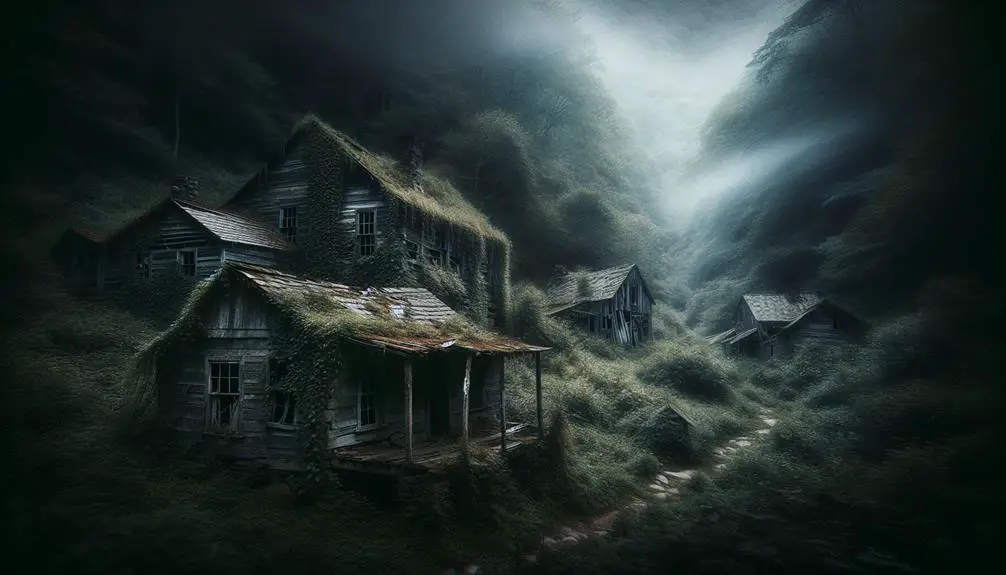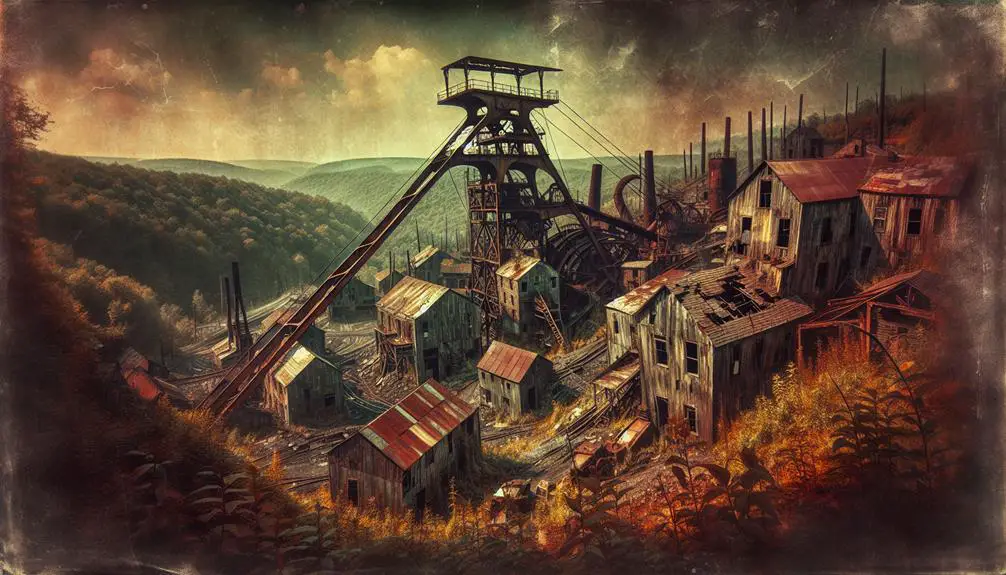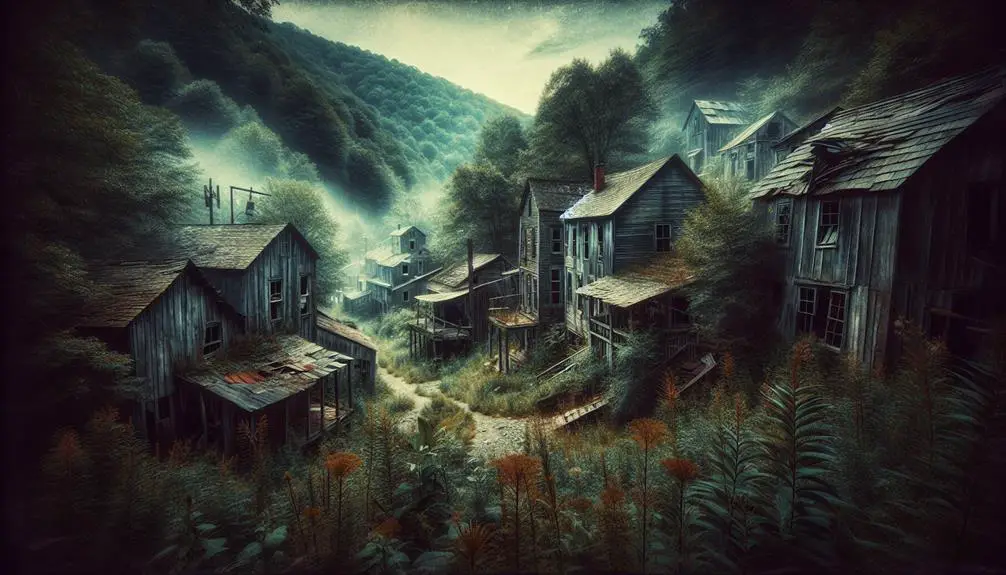Discover the fate of Appalachian Mountain ghost town residents. Economic hardships and dwindling resources forced families to migrate, fracturing once tight-knit communities. Residents faced challenges adapting to new environments, battling against despair and isolation. Social structures crumbled as demographics shifted, leaving behind a complex tapestry of resilience and traditions. The cultural legacy of these dwellers lives on, echoing through time with tales of perseverance and resourcefulness. The absence of these forgotten residents leaves a haunting impact, prompting reflection on human fragility and enduring connections. Explore the intricate web of experiences that shaped the lives of ghost town residents.
Key Points
- Economic downturn and resource depletion led to migration to cities.
- Residents faced challenges starting anew in unfamiliar urban settings.
- Decline in industries caused poverty, anxiety, and lack of healthcare.
- Social structures shifted, creating new leaders and roles.
- Cultural legacy preserved through folklore, traditions, and resilience.
Migration Patterns of Ghost Town Residents
When studying the migration patterns of ghost town residents, it becomes evident that their movements were influenced by economic downturns and natural resource depletion. Demographic shifts played an important role as families sought new opportunities in cities, leaving behind once-thriving communities. The ties that bound these towns together began to unravel as people dispersed in search of better prospects.
Relocation challenges loomed large as residents grappled with starting anew in unfamiliar surroundings. The struggle to preserve the historical essence of their ghost towns added another layer of complexity to their decisions. Balancing the need for progress with the desire to honor the past posed a dilemma for many.
Analyzing the data reveals a moving narrative of resilience and adaptation in the face of adversity. The ghost town residents faced a crossroads, where the past and future intersected, shaping their destinies in ways unforeseen. The echoes of their migrations reverberate through the Appalachian Mountains, a proof to the enduring spirit of those who sought to forge their paths amidst changing landscapes.
Economic Decline Impact on Residents
The economic decline in the region had a profound impact on the resilience and adaptability of the Appalachian Mountain ghost town residents. As industries dwindled and jobs became scarce, residents found themselves trapped in a vicious cycle of poverty, struggling to make ends meet and provide for their families. The loss of stable employment opportunities not only affected their financial well-being but also took a toll on their mental health.
The constant stress of trying to survive in an environment of economic uncertainty led to higher levels of anxiety, depression, and feelings of hopelessness among the residents. As resources became scarce, accessing proper healthcare or mental health services became a luxury many couldn't afford. The lack of support systems and the erosion of community structures further exacerbated the challenges faced by the residents, pushing them deeper into isolation and despair.
The economic downturn not only impacted the residents' financial stability but also had long-lasting effects on their mental and emotional well-being, trapping them in a cycle of poverty that was hard to break free from.
Social Structures in Abandoned Communities
Social dynamics within abandoned communities reveal intricate webs of interconnected relationships that shape the daily lives of residents who navigate the remnants of a once-thriving society. In these ghost towns, community relationships take on new meanings as social hierarchies shift and adapt to the changing landscape. The absence of formal structures like businesses or local government often leads to the emergence of essential leaders who wield influence based on factors like age, experience, or skills valuable to survival.
Within these communities, social hierarchies can be fluid, with individuals carving out roles based on their strengths and contributions to the group. You may find that those with knowledge of farming techniques become vital figures, while others skilled in hunting or crafting take on equally important roles. These dynamics not only help the community survive but also shape the interactions and relationships among residents, fostering a sense of unity and cooperation in the face of adversity. Despite the challenges of living in abandoned communities, the social structures that emerge highlight the resilience and adaptability of human connections in the most unexpected of places.
Cultural Legacy of Ghost Town Dwellers
Amidst the remnants of Appalachian mountain ghost towns, the cultural legacy of dwellers echoes through time, revealing a tapestry of traditions and practices that have withstood the test of abandonment. The resilience of these cultural traditions is evident in the folklore preservation of these once-thriving communities. Stories passed down through generations continue to captivate with their mystical charm, providing a window into the lives of those who called these ghost towns home.
The cultural fabric woven by ghost town dwellers is rich and diverse, reflecting a blend of Appalachian heritage and the unique circumstances of living in isolated mountain communities. From music and dance to culinary delights and craftsmanship, the traditions of these residents showcase a deep connection to the land and a resourcefulness born out of necessity.
Exploring the cultural legacy of ghost town dwellers offers a glimpse into a world where resilience and creativity were essential for survival. By preserving their folklore and traditions, these communities have left a lasting imprint on Appalachian history, inspiring future generations to cherish and learn from the past.
Modern Perspectives on Forgotten Residents
Peering into the remnants of Appalachian mountain ghost towns reveals a haunting absence, yet prompts contemplation on the modern perspectives regarding the forgotten residents who once inhabited these desolate landscapes. The community bonds that were once tightly woven among these residents seem to linger in the air, hinting at the shared experiences and hardships they endured together. As modern society reflects on these individuals, a psychological impact emerges, raising questions about the resilience and adaptability of those who were forced to abandon their homes.
In today's world, where connections are often fleeting and transient, the idea of a community so deeply interconnected evokes a sense of longing for the kind of support and camaraderie that seemed inherent in these ghost towns. The psychological impact of being uprooted from such a tight-knit environment likely left lasting scars on those who experienced it, reminding us of the fragility of human existence and the importance of fostering lasting connections with those around us.
Frequently Asked Questions
What Role Did Superstitions and Folklore Play in the Lives of Appalachian Mountain Ghost Town Residents?
In your lives, superstitions and folklore were like threads weaving through the fabric of your existence. Beliefs passed down, shaping traditions and guiding actions. The mystical whispers of the past echoed in your present.
How Did the Isolated Nature of These Communities Impact Residents' Mental Health and Well-Being?
Isolation effects in Appalachian ghost town communities greatly impacted mental health concerns. Residents struggled with limited resources, loneliness, and lack of access to healthcare. These challenges took a toll on well-being, leading to various mental health issues.
Were There Any Unique Traditions or Customs That Were Specific to Appalachian Mountain Ghost Town Residents?
In Appalachian Mountain ghost towns, unique traditions and customs were intertwined with Appalachian folklore and superstitions. Residents cherished their heritage by passing down stories, music, and crafts, creating a rich tapestry of cultural practices.
How Did the Natural Environment of the Appalachian Mountains Shape the Daily Lives of Ghost Town Residents?
Amidst the rugged Appalachians, each dawn greeted you with whispers of ancient trees and misty valleys, shaping your daily rituals. The natural landscape dictated your chores, seasons dictated your harvests, weaving life's tapestry.
What Impact Did the Decline of Traditional Industries, Such as Coal Mining, Have on the Cultural Identity of These Communities?
When the decline of traditional industries like coal mining hit, the cultural identity of these communities took a hard blow. Impact was profound, as livelihoods tied to these jobs were lost, altering the fabric of their existence.



